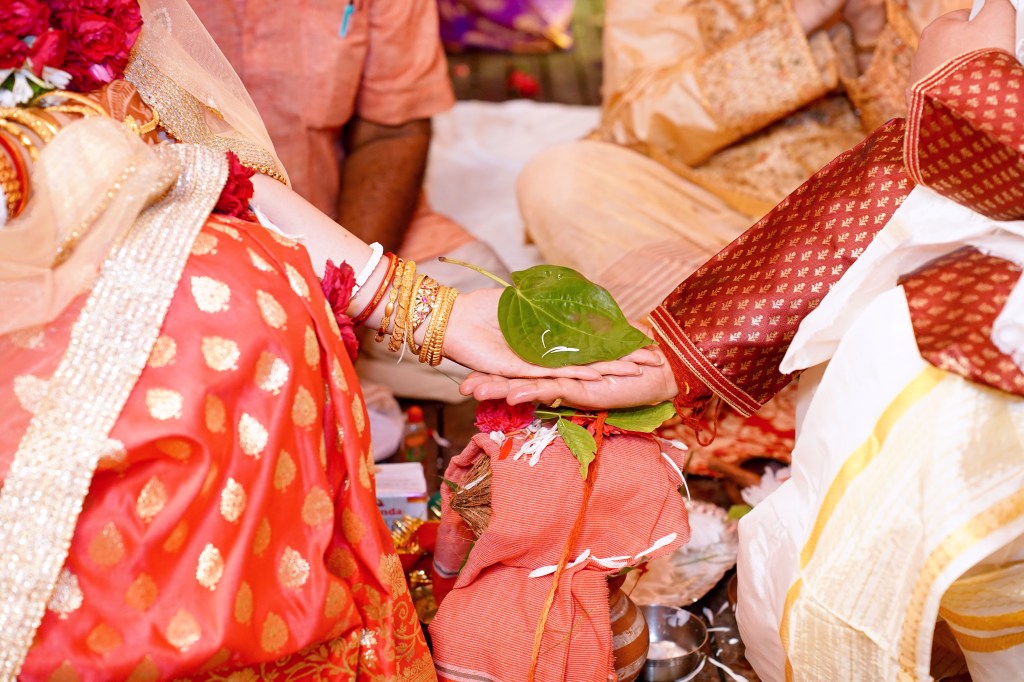
My younger daughter Piya’s wedding was being celebrated.
The interesting thing was that though I have participated in several Bengali weddings, including my own. over the years, this one was providing me a refreshing ‘stand and stare’ perspective of the goings-on. Was this because this was ostensibly the last big event in the family? Or was it because of my acquiring a more relaxed and less impatient mindset with advancing age? I remained unsure.
The Tubri firecracker of Bengal has no real parallel elsewhere. When lit, the small round earthen pot emanates a gentle gurgling sound with tiny sparks coming out of the hole. The intensity increases with the colourful sparkles streaming up to great heights, accompanied by the rising crescendo of the combustion sound.
Like the Tubri, the Bengali Wedding too starts as a gentle symphony of fun and bonhomie which then blooms into a larger-than-life event showcased through a riot of colour, lights, feasting, and rituals.
Ai Buro Bhat, that Bachelorette and Rice event. The last ‘big meal’ of the would-be bride as a bachelor!
It is a much-awaited ritual and the wedding bell starts to ring as family and friends gather to bless the bride-to-be. A sumptuous meal awaits her and the others present. Ranging as it does from fish and meat dishes, fried foods to Mishti, the traditional Bengali sweets. A fun event replete with jokes, reminiscences by the elders, and banter.

The blessing…..as my nonagenarian ( 90 years old) mother blows the conch shell

Ai Buro Bhat
The pre-wedding evening gets packed with four events.
The Mehndi event is all about creating exquisite body art through the application of Mehndi or Henna. An event in which the bride-to-be and other ladies participate. As the evening progresses, Mehndi, that red-orange stain applied on the palms and hands, keeps on darkening! It is said that the darker the mehndi, the more would be love in the air.

Mehndi mysticism
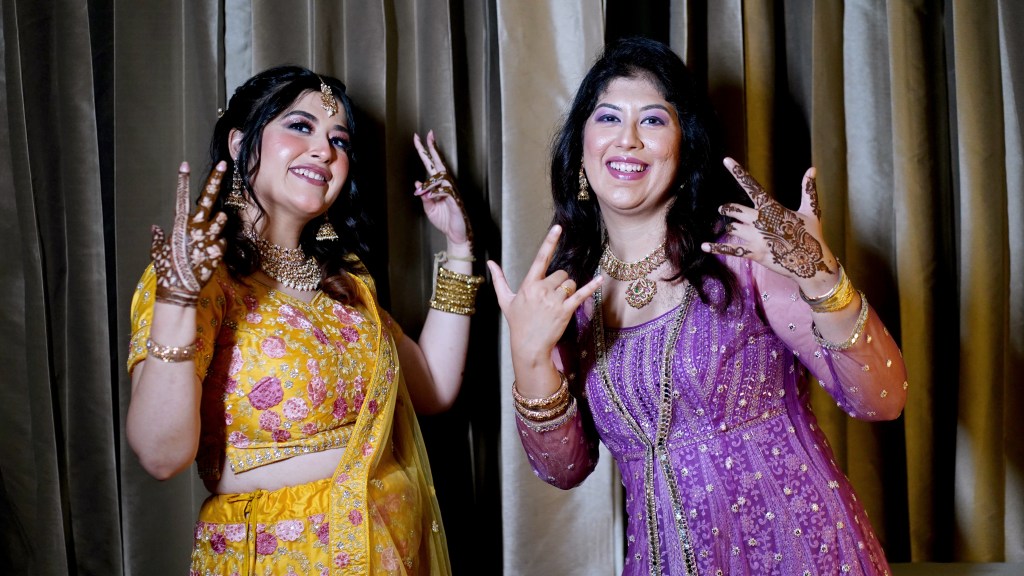
Those exquisite designs
Ashirbaad, the Bengali pre-wedding ceremony, is all about blessing the would-be couple. The ritual is symbolized by parents and senior family members putting dhaan, rice husk and dubyo, trefoil leaves on the heads of the to-be-weds, along with exchanging gifts of gold jewellery, clothes, and sweets.
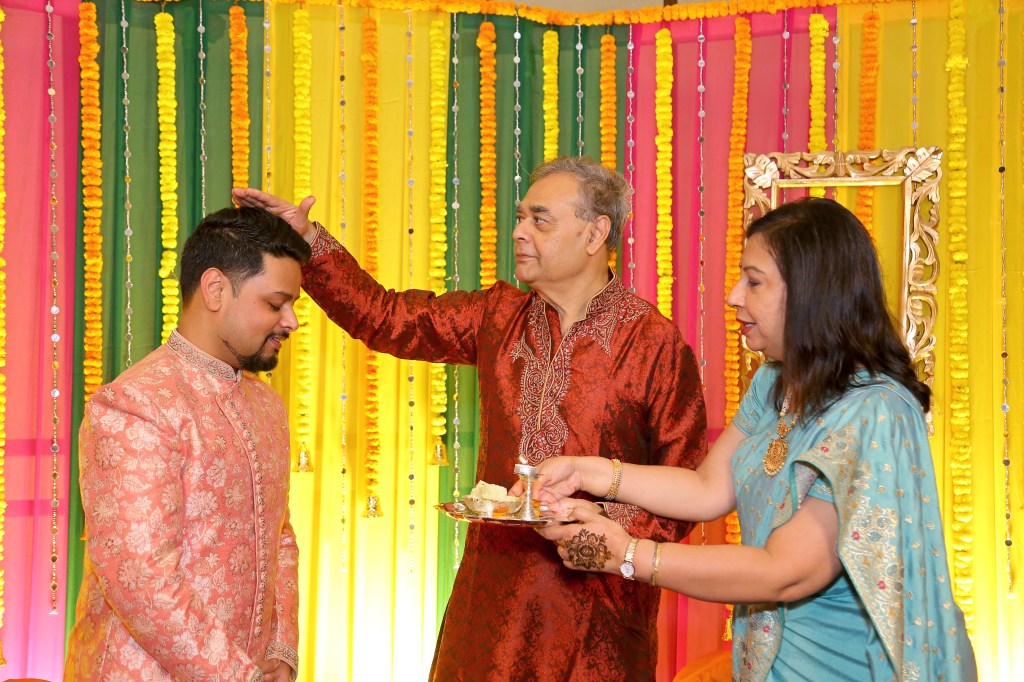
Ashirbaad

The blessing
Sangeet literally means music. The Sangeet event with its music and dance, is a celebration of the wedding union and bonding. Everyone is expected to let one’s hair down and shake a leg. Be it through impromptu jiving or a choreographed dance performance.
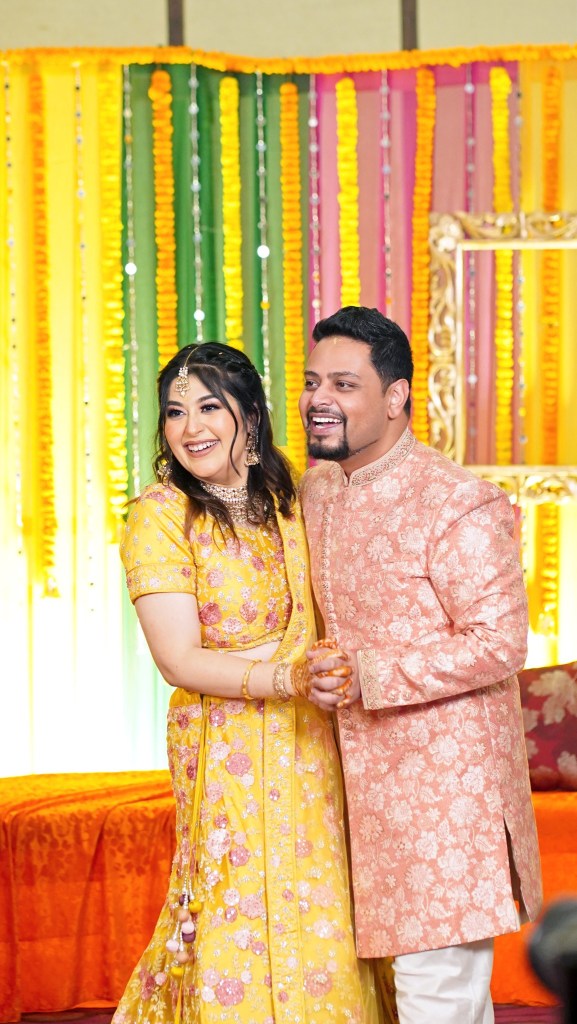
Let’s waltz into the future….
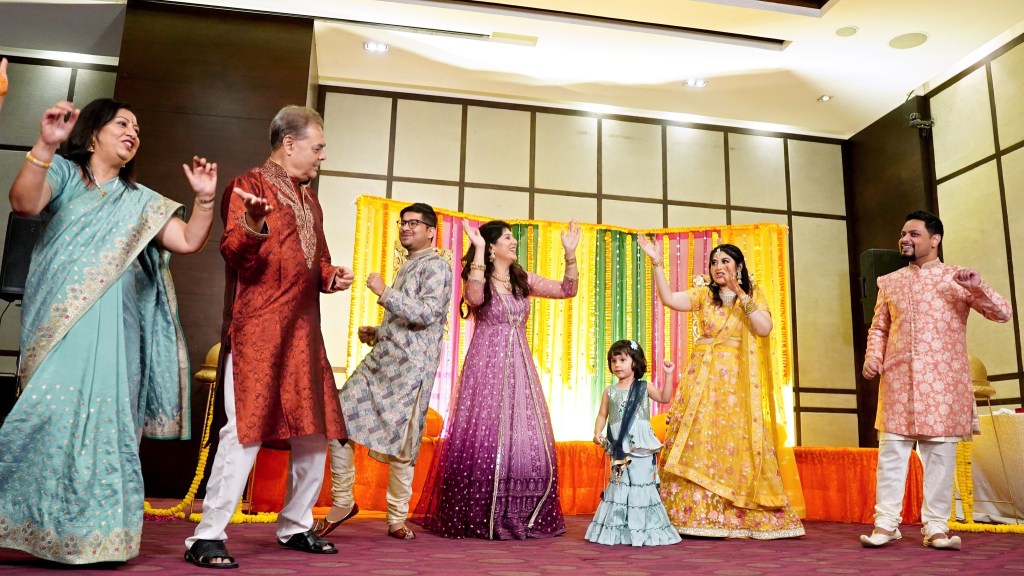
Shall we jive?

Shake a leg

Rock n’ roll!
And finally, it is about that one ring that signifies a resolve to join together in life’s journey. The Engagement ring ceremony.

The engagement
Comes the Bengali Wedding Day when the bride and the groom tie the knot.
The morning starts with the Gaye Holud ritual. Gaye Holud is all about smearing turmeric paste on the bride’s face and body. The ‘groom smeared’ turmeric is brought for the bride by the groom’s family members. Apart from being considered a beautifying and brightening agent, turmeric symbolizes healthy relationships for the future.

Gaye Holud
The Bengali wedding has the practice of exchanging attractively packaged gifts. The bridegroom’s family members bring these along with the bowl of turmeric paste for the gaye holud. All those brightly decorated tatta trays, containing as they do clothes, gifts and accessories, are a visual delight. Apart from the sheer creative effort to make them, Tatta trays are supposed to bring with them abundant blessings and good wishes.

Totto ……. can you spot the decked-up fish?
Bor Boron is all about formally welcoming the groom to the wedding. The Bor, Groom arrives with his bor jatri entourage (On his wedding day, Piyush the groom, and all the others had to come through a heavy downpour!). The bride’s mother does Boron viz. blesses and welcomes the groom at the entrance with a kula, bamboo winnow accompanied by the sounds of Uludhwani, before the latter is escorted to the Chhadnatola, the wedding mandap.

Bor Boron

Bor Jatri
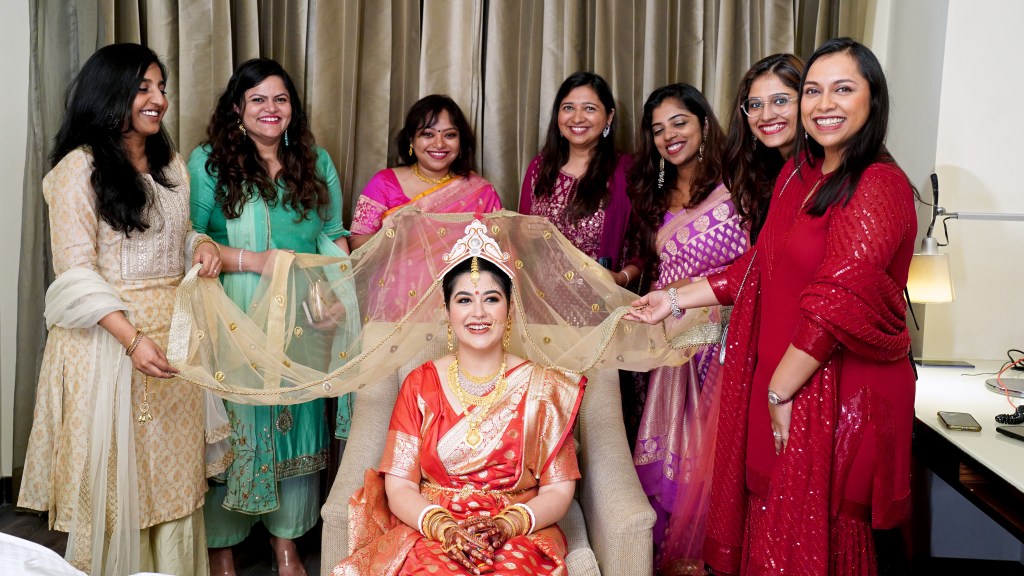
Quintessential Bengali bride
Subho Dhristi is that first exchange of glances between the bride and the groom. Carried on a pidi, a wooden stool, seven times around the standing groom, the bride keeps her face covered with paan patta. betel leaves before slowly revealing her face for that auspicious glance.

Prelude to Shubho Drishti
Comes the Mala Bodol in which the bride and the groom garland each other thrice, the Sampradan in which the father ‘hands over’ his daughter, the bride, to the groom and the Anjali in which the groom holds the bride’s hands from behind as they offer khoi, puffed rice to the sacred yagna fire.

Mala Bodol

Sampradan

Anjali
The evening is still young … so photo opportunity, some dancing, good food, and drinks for all!

Newly weds

The evening is young!

Let’s make some noise!
Next morning and it is time for the bittersweet custom of Bidaye. The bride bids farewell to her parents and other family members as she gets ready to accompany her newly wedded husband to his home.
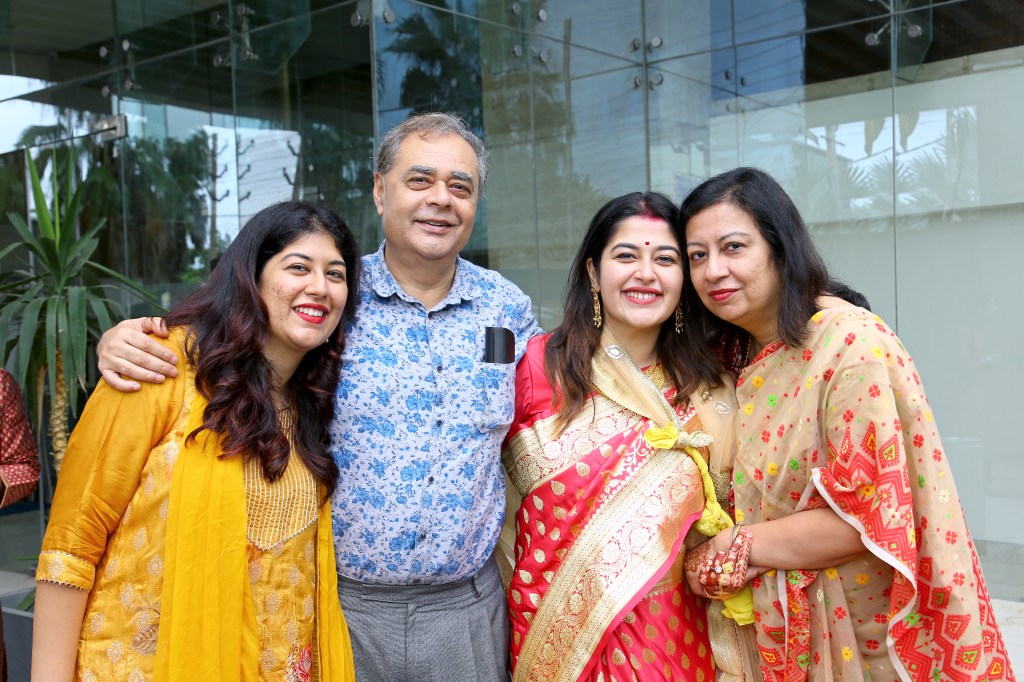
Bidaye
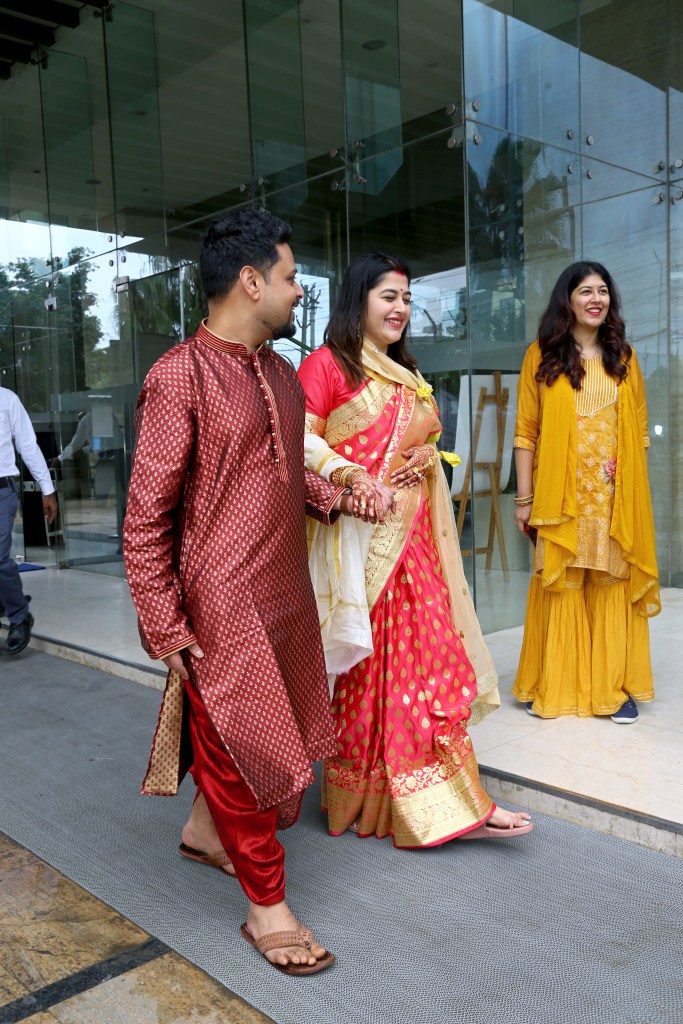
Let’s go home.
As the Bride reaches her new abode, she is welcomed by her mother-in-law with Arati, a ritual meant to bring in light. She steps into an Alta (red dye) filled tray and then walks onto a white cloth. Those alta laced red footprints on the cloth are supposed to herald Goddess Lakshmi into the household.

Arati

Lakshmi steps
It is the day of the Bou Bhaat and the wedding reception.
Bou Bhaat literally means bride’s feast. It signifies two things. As the bride settles down in her new home, it is time for the bhat Kapor ritual in which she is offered a new saree and jewellery by her newly wedded husband signifying that he takes responsibility for her food and clothes from now on. The bride then serves rice to all family members implying that she is now part of the household.

Bhat Kapor

Bou Bhat
In the evening, the groom’s family invites all family members and friends to a preetibhoj or a gala dinner. The bride’s family, the kone jatri , are guests of honour at this reception.

Welcome to our beginning!

The arrival

The wedding cake

Preetibhoj
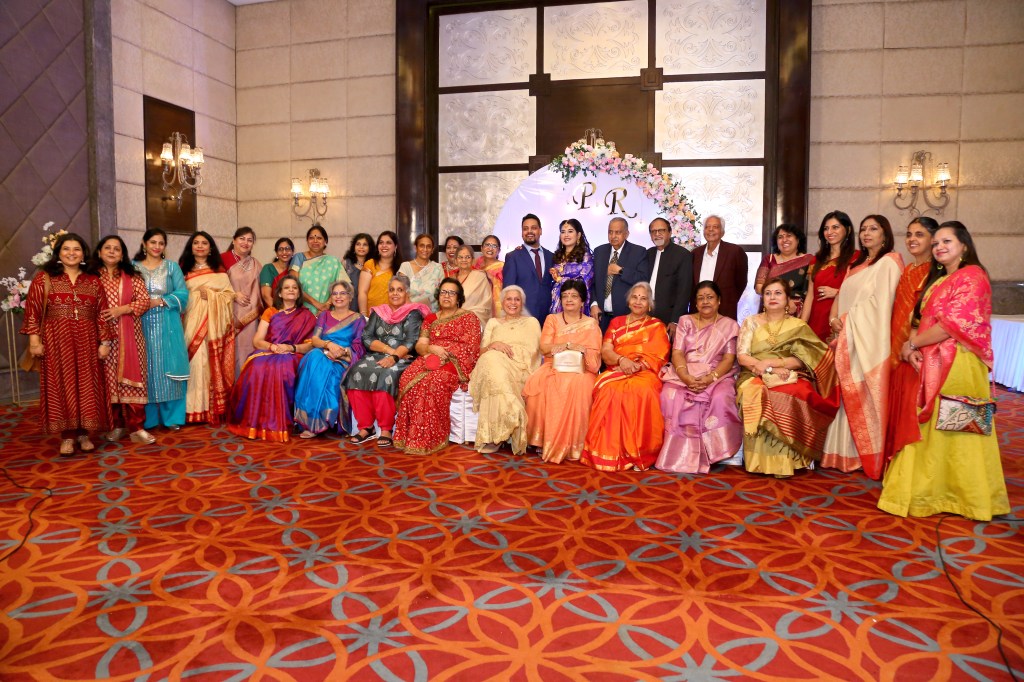
Guests @ the Gala Dinner

What does the future hold in store?
As an observer of the wedding events and rituals, I sensed how the Bengali Wedding has been able to maintain vibrancy and relevance by imbibing popular parts from elsewhere. The Sangeet custom is an import from Punjab and North India. The Mehndi tradition is from the Middle East and according to some sources, was brought into North India by the Moghuls. Over the years, it has become part of Bengali weddings too. The wedding cake, with its origins in ancient Rome, has always been part of wedding traditions in Europe. It has become increasingly popular in Indian and Bengali weddings. An eclectic blend of these customs from elsewhere with the traditional Bengali ones made the whole event a fascinating one for me.
Piya and Piyush’s wedding also made me recall the few lines I had penned about a Bengali wedding of a century back in my book, The Chronicler of the Hooghly and other stories:
“Thoughts and memories coalesced.
Malati looking at Dipen shyly from under her ghomta, saree drawn over eyes, on their wedding night during shubha drishti.
Malati being raised higher and higher by her brothers in fun to prevent Dipen from garlanding her easily during their wedding.”
I was left with the realisation that even though our society and the collective mindset have changed beyond recognition over the last hundred years, somewhere, somehow the glue of our customs and rituals has provided a reassuring continuity.
Shakti Ghosal

